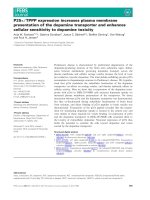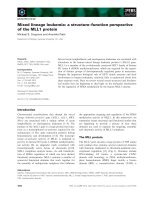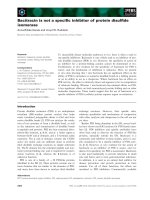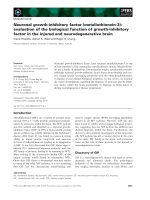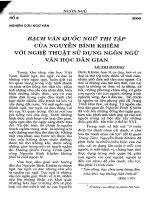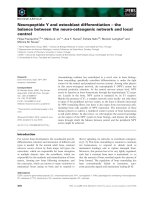Tài liệu Báo cáo khoa học: "Universal Grammar and Lexis for Quick Ramp-Up of MT Systems" doc
Bạn đang xem bản rút gọn của tài liệu. Xem và tải ngay bản đầy đủ của tài liệu tại đây (457.36 KB, 5 trang )
Universal Grammar and Lexis for Quick Ramp-Up of MT
Systems
Abstract
This paper introduces Boas, a semi-automatic
knowledge elicitation system that guides a team of
two people through the process of developing the
static knowledge sources for a moderate-quality,
broad-coverage MT system from any "low-den-
sity" language into English in about six months.
The paper focuses on some issues in the elicitation
of descriptive knowledge in Boas and also the issue
of the principled reuse of pre-existing resources,
such as a lexicon, an ontology, and an English gen-
eration module, among others, made possible by
the fact that the client MT system is developed for
a single target language.
1. Introduction: The Boas Project
This paper presents Boas, a semi-automatic knowl-
edge elicitation system that guides a team of two
people through the process of developing static
knowledge sources for a moderate-quality, broad-
coverage MT system from any "low-density"l lan-
guage into English in about six months. Boas con-
tains knowledge about human language and means
of realization of its phenomena in a number of spe-
cific languages and is, thus, a kind of a "linguist in
the box" that helps non-professional acquirers with
the task, whose complexity is legendary. 2
Sergei Nirenburg and Victor Raskin
Computing Research Laboratory
New Mexico State University
Las Cruces, N.M. 88003, U.S.A.
{ sergei, raskin } @ crl.nmsu.edu
dictated by the amount of language work which can
be carded out, given the resources available. The
rules of the game specifically exclude linguists and
MT developers from the acquisition team. Under
such conditions, the only sensible course of action
is to attempt to collect as much knowledge about as
many languages as possible in advance and include
it in the elicitation system itself.
Section 2 below is devoted to defining the format
of the descriptive language knowledge to be elic-
ited from the acquirers through Boas. The descrip-
tive language knowledge, which we address in this
paper, is, later in the process of Boas operation,
converted into operational knowledge capable of
supporting the processes of source language analy-
sis and source-target transfer. In Section 3, we dis-
cuss how work on ontological semantics in MT can
contribute to Boas in a situation of a single target
language, English. In Section 4, we address the
procedure for descriptive language knowledge
acquisition in Boas, both in terms of resources cre-
ated and reused and in terms of the actual elicita-
tion techniques, differentiating between the
acquisition of grammatical and lexical parameters.
The knowledge about language elicited by Boas
from the acquirers aims to support MT output qual-
ity which is roughly commensurate with the out-
puts of the better commercial systems, such as
Systran. These relatively modest expectations are
1 "Density" refers roughly to the amount of effort having been
previously expended in the field on computational descriptions
of particular languages, resulting in the creation of a variety of
machine-tractable resources text corpora, grammars, lexi.
cons, analyzers, etc. Thus, Spanish will most probably count a ;
"high-density" while, say, Tagalog will not.
2. Defining Parameters for Boas
The descriptive knowledge about the source lan-
guage is a set of statements about morphological,
syntactic, and lexical properties (parameters) of a
language, listed together with their values and real-
ization options. Data about each parameter
includes the language, the name of the parameter,
the list of entities to which this parameter applies
(its domain) and the list of parameter values (its
2
We have introduced Boas and discussed some per-
tinent theoretical issues in Nirenburg (1998). In this
paper, we focus on the more practical aspects of
Boas implementation.
975
range). Moreover, parameter values have an associ-
ated set of realization options in each language. For
instance, the parameter of gender in Ukrainian is
described as follows:
language: Ukrainian
parameter: gender
domain: nouns, adjectives, possessives (head agree-
ment), verbs in past tense
range (parameter values): masculine, feminine, neuter
realization: [gender markers in lexicon for nouns;
inflection paradigms for adjectives, possessives and
verbs in past tense]
For comparison, the Hebrew gender is described
differently:
language: Hebrew
parameter: gender
domain: nouns, adjectives, possessive (non-first-person
possessor agreement), finite verbs
range (parameter values): masculine, feminine
realization: [gender markers in lexicon for nouns; gen-
der inflection paradigms for adjectives, possessives and
verbs]
Instead of discovering parameters from scratch for
each language, it is preferable, in order to ensure
uniformity and systematicity of Boas operation, to
come up with a complete list of all possible param-
eters in natural languages, with complete lists of
their possible values attached. The attainability of
such a resource becomes then a central issue.
The terms 'parameter' and 'value' are used in our
task in the same sense as in the school of theoreti-
cal syntactic thought consecutively known as gov-
ernment and binding (Chomsky 1981), principles
and parameters (Chomsky 1986) and the minimal-
ist position (Chomsky 1995). The theory postulates
a small number of general principles defining the
innate human language faculty and a larger number
of language parameters, which implement these
principles by selecting concrete values for particu-
lar languages. The complete set of such parameters
and values constitutes a universal grammar (UG)
see also Culikover (1997), Lightfoot (1991) an(
Webelhuth (1992).
Unfortunately, work within this approach has no~
stressed the descriptive task of creating a compre-
hensive inventory of universal grammar parame-
ters or even those for particular languages o]
language families. For Project Boas, it means tha~.
both the nature of the parameters it would be using
and their inventory has to be developed in-house.
In order to define a set of parameters for Boas, it is
essential to distinguish among the language phe-
nomena that should be accorded the status of
parameter and those that should be understood as
parameter values or their realizations. Still other
phenomena may remain, at least for the task at
hand, outside the parameter system. We believe,
with Dorr (1993), that parameters may be under-
stood as building blocks of an interlingua in MT.
We reserve judgment about whether every compo-
nent of an interlingua is by definition parametric 3.
Thus, the parameter "lexical category" has a range
of values { V, N, Adj, Adv, }. Any of these values
may itself be considered a parameter. If viewed
within a single language, their values are, ulti-
mately, all words in the language which belong to
the respective lexical categories. The realizations
of these values are the specific forms of these
words, which appear in text decorated with realiza-
tions of appropriate values of such morphological
parameters as NUMBER, GENDER, CASE, etc.
An example of a syntactic parameter is HEAD-MOD-
IFIER DEPENDENCY, whose values include such
pairs as "head: noun; modifier: adjective; head:
verb; modifier: adverb," "head: noun; modifier:
relative clause" and others. Realization options for
these values involve word or constituent order
rules (for instance, post- or pre-posing) and agree-
ment rules.
Lexical parameters are viewed as language-inde-
pendent lexical meanings (ontological concepts),
such as TABLEFuRNITUR E. The values of this parame-
ter are the word senses corresponding to this onto-
logical concept across the inventory of languages.
The realizations for these values are the words or
phrases that express this meaning in each language,
with a possibility of a lexical gap (a null value)
3 Thus, for instance, a morphological analyzer for
Turkish uses information that does not have to be
expressed parametrically, such as data about nomi-
nal suffixes, which one needs to know in order to
recognize a noun form but which do not correspond
to any parametric value that needs to be expressed
in English; similarly, a Russian verbal prefix may
help determine the aspect value but does not realize
a distinct parametric value of its own.
976
included. Sense: furniture
3. Translation Environment Supported by Boas
The single-target-language (English) environment
which Boas serves allows for simplification of both
system implementation and the acquisition process
compared to the case of multiple SLs and TLs.
First, only one text synthesis module needs to be
built. Second, many fewer transfer components
(bilingual lexicons, transduction tables for closed-
class lexical items, feature and structure transfer
tables) are needed. In fact, this situation almost
licenses the transfer approach, as the combinatorial
argument for interlingual MT is weaker here than
in the case of multiple TLs (see, however, below
and fn. 3). Third, it appears that knowledge acqui-
sition for a new SL may be aided by the presence
of a number of resources already developed for the
TL.
These resources include a) the vocabulary of the
generation lexicon which can serve as the list of
lexical parameters for compiling the bilingual dic-
tionary; b) a world model (ontology) providing the
terms in which the senses of the English words and
phrases are expressed (Boas uses the ontology
from the Mikrokosmos project at NMSU CRL
see Mahesh and Nirenburg 1995); c) the structure
and term definitions from the text meaning repre-
sentation in Mikrokosmos (see, for instance, Ony-
shkevych and Nirenburg 1995), to help guide
parameter elicitation; d) the set of English closed-
class lexical items and morphemes; e) English
grammar used in text synthesis, which provides the
TL side of structural transfer rules in the runtime
MT system (see Figure 1 above); and f) a set of
"ecological" parameters and their realizations for
English. While a complete description of the use of
all of the above resources is beyond the scope of
this paper, we will give a few brief illustrations.
The list of English word senses seeds the acquisi-
tion of the SL lexicon. The acquirer first simply
translates all the word senses into SL and then adds
SL features to the corresponding entries as needed.
The result is an SL-TL transfer dictionary which
also serves as the lexicon for SL analysis. The
acquirer gets a lemma with all its senses:
Entry: table-n 1
POS:
noun
Entry: table-n2
POS:
noun
Sense: diagram
and produces the following SL lexicon entries (the
example is in Hebrew):
Entry: shulxan-n 1
POS:
noun
Gender: m (plural -ot)
Sense: table-nl
Entry: tavla-nl
POS:
noun
Gender: f
Sense: table-n2.
In the examples, the senses are conveniently
explained not in any specially designed lexicon/
ontology notation, but rather through translation
into English. Because each English translation is
the entry head for a sense which is already
explained in an ontology-based semantic metalan-
guage in the already existing Mikrokosmos lexi-
con, Expedition can benefit from richer semantic
information than that acquired using Boas.We use
the Mikrokosmos ontology as a search space to
support word sense disambiguation. The method
(suggested by Jim Cowie) depends on the bilingual
dictionary of the kind illustrated above. Coarse
grain-size lexical mappings of TL word senses to
ontological concepts are established (for instance,
chihuahua and poodle may be both linked to the
ontological concept
DOG).
The system, thus, knows
that both chihuahuas and poodles have four legs,
are carnivorous, domesticated, etc.
The disambiguation method uses such ontological
constraints by computing a distance in the ontolog-
ical space between ambiguous word senses on the
one hand and the senses of other words in their
context. SL syntactic information helps to guide
the disambiguation process by providing additional
constraints. Thus, closeness between senses of
words belonging to the same syntactic unit is
weighed more heavily than that across unit bound-
aries.
The acquisition of the complete list of parameters
in the single-TL environment is facilitated not only
by the availability of the initial set of lexical
parameters but also by the prominence of the syn-
977
tactic and morphological parameters activated in
English. Thus, for morphology and syntax, the
existence of such comprehensive grammars of
English as Quirk
et al.
(1985) allows a quick
round-up of the major parameters. One cannot
always limit oneself, however, to TL-induced
acquisition as we have demonstrated in the previ-
ous section on the example of GENDER in English.
4. Source Language Knowledge Acquisition
Acquisition of descriptive knowledge about a lan-
guage consists in Boas of a set of elicitation "epi-
sodes." The episodes have been clustered, very
unevenly, into six large classes, namely, morphol-
ogy, closed-class items, open-class items, syntax,
transfer features, and ecology. Each episode is an
HTML document, accessible through the standard
Web browsers. Each page deals with one parameter
and elicits information on its values present in the
source language as well as the realizations of these
values. It is morphology which seems to require
the greatest number of parametric episodes, though
the total is not very high: verbs, around 30 episodes
for the finite forms, and about 40 for the non-finite
forms; nouns, around 20; adverbs and adjectives,
under 5. Morphology does include these four sec-
tions.
Closed-class items are pronouns, temporal rela-
tions, spatial relations, and case-like relations, e.g.,
prepositional phrases (the morphological case is, of
course, handled in the noun section of the morphol-
ogy class). Each closed-class page deals with one
English closed-class item in one appropriate sense
and elicits all the possible translations of that item
into the source language (or, more accurately, all
possible expressions in the source language which
may be translated into English with this item in this
sense), with the complete morphological and syn-
tactic information on each such translation.
Because there are, roughly, 200 closed-items in
English (and many other languages), this class
requires the greatest number of Web pages but they
are mot parametric and quite straightforward.
Open-class items are acquired lexically, with the
help of, essentially, one huge standard elicitation
episode/Web page. Lexical acquisition proceeds as
described in Section 3 and further aided by a spe-
cial resource created for Boas/Expedition: continu-
ing our work on significantly reducing the number
of different senses in a lexicon entry by combining
related senses in MRDs (see Nirenburg
et al.
1995)
and, more rarely, deleting the marginal ones, we
have manually reduced a combined (Mikrokosmos
and other sources) English lexicon of about 28,000
words to about 40,000 word senses, each of which
serves as a lexical parameter for SL acquisition. In
addition, frequency analyses of SL corpora will
provide the requirements for adding lexical param-
eters from SL, not just TL.
Syntax will have rather few elicitation episodes
since much of it will be collected automatically
from a large corpus, pre-tagged morphologically
by Boas automatically.
The elicitation pages in transfer features class will
deal with non-standard transfer correpondences,
and ecology with proper names, punctuation, stan-
dard acronyms for numbers, and other print con-
ventions of the source language. It is unlikely to be
a very numerous class and it is, of course, largely
non-parametric.
It is the morphology class which has necessitated
the heaviest use of and most remedial effort on
parameter inventories. We have largely expanded
the inventory of parameters, previously acquired in
the PROPERTY branch of the Mikrokosmos ontol-
ogy: most of the "grammatical" meanings, realized
in any one of the Mikrokosmos languages, such as
English, Spanish, and Chinese, are already
recorded and systematized there. We have also had
to compile what we hope to turn out to be the most
complete list of both parameters and their values,
such as noun case (around 30 values), verb mood
(about a dozen), verb aspect (about two dozen),
etc.
A standard morphological episode elicits the val-
ues for a parameter which the user has already
marked as present in the source language on the
previous Web page. The moment the box for that
parameter was checked there, the user is taken to
the values page, where Boas offers a complete list
of existing values for that parameter and requests
that the user select all that apply.
Two additional factors deserve a special mention.
First, each elicitation episode is supported with
context-sensitive online help, which can be also
accessed as a complete morphological, syntactic,
closed-class, etc. tutorial. This tutorial, as far as we
978
know, is the only available sketch of universal
grammar. Secondly, each parameter and value
choice provides for the selection of "other"
unlisted values, and great care is taken to assist the
user in naming the parameter or value as well as
determining the appropriate values for each user-
introduced parameter with the appropriate realiza-
tions.
At the conclusion of each elicitation cycle, such as
nouns or verb finite forms, all the elicited informa-
tion is presented to the user for checking, correct-
ing, and editing in the form of a paradigm table,
which id the Cartesian product of all the estab-
lished parameters and values. The user is also
guided through the parts of the source language
grammar which deals with exceptional paradigms.
It should be also noted that, in open-class acquisi-
tion, the paradigms for each acquired source lan-
guage item will be assigned to one of the already
established types or, alternatively, a new excep-
tional type will be added, if necessary.
The most difficult issues in acquisition involve the
transcategorial realization of values, such as the
signalling of a noun case in the verb or non-stan-
dard clitics, or the lexical realizations in SL of
grammatical parameters in TL, such as the possible
absence of continuous tenses in a SL and the
choice of a grammatical realization of such lexical
values as "right now" in the SL as the present con-
tinuous marker on the corresponding verb. Interest-
ingly also, clitics and similar morphological
"complications" of source languages are unlikely
to present a significant problem either in elicitation
or in transfer, primarily because of the single target
language environment in Boas and ensuing lack of
necessity to generate (rather than just to analyze)
much morphological complexity.
5. Conclusion: Computational Field
Linguistics?
Boas exemplifies the broad-coverage descriptive
approach to NLP (see, for instance, Nirenburg and
Raskin 1996) and adds to it a complementary new
commitment to developing and using automated
field-linguistic methodology (cf. Nirenburg 1998).
This goes hand in hand with the evolving reorienta-
tion of theoretical linguistics from selective theo-
rizing, in terms of prevalent atomistic rule
postulation and testing, back to the primary goal of
linguistics, which is a theory-based language
description.
A full evaluation of Boas, that is, the development
of the first actual SL to English MT system over a
six-month time interval, will take place within the
next two years.
Acknowledgments
The research reported in this paper was sup-
ported by Contract MDA904-92-C-5189 with the
U.S. Department of Defense. Victor Raskin is
grateful to Purdue University for permitting him to
consult CRL/NMSU.
References
Chomsky, N. 1981. Lectures
on Government and
Binding. Dordrecht: Foris.
Cbomsky, N. 1986.
Knowledge of Language:
Its Na-
ture,
Origin, and
Use. New York: Praeger.
Chomsky, N. 1995.
The Minimalist Program.
Cam-
bridge, MA: MIT Press.
Comrie, B., and N. Smith 1977. Lingua Descriptive
Studies: Questionnaire. Lingua 42:1, pp. 1-72.
Culikover, P. W. 1997.
Principles and Parameters. An
Introduction to Syntactic
Theory. Oxford
University Press.
Dorr, B. 1993. Interlingual Machine Translation: A Pa-
rametrized Approach.
Artificial Intelligence
63,
429-92.
Lightfoot, D. 1991. How
to Set Parameters.
Cam-
bridge, MA: MIT Press
Mahesh, K., and S. Nirenburg 1995. Semantic Classifi-
cation for Practical Natural Language Process-
ing. In:
Proceedings of the Sixth
ASlS SIG/
CR Classification Research Workshop: An
Interdisciplinary Meeting.
Chicago, IL.
Nirenburg, S. 1998. Project Boas: "A Linguist in the
Box" as a Multi-Purpose Language Resource.
In: Proceedings of The First Lexical
Resources and Evaluation Conference.
Granada, Spain.
Nirenburg, S., and V. Raskin 19961 Ten Choices in Lexi-
cal Semantics. MCCS-96-304, Las Cruces,
N.M.: NMSU CRL.
Nirenburg, S,, V. Raskin, and B. Onyshkevych 1995.
Apologiae Ontologiae. TMI '95, Leuven.
Onyshkevych, B., and S. Nirenburg. 1995. "A Lexicon
for Knowledge-Based MT."
Machine
Translation,
10:1-2, pp. 5-57.
Quirk, R., S. Greenbaum, G. Leech, and J. Svartvik
1985.
A Comprehensive Grammar of the
English Language. London: Longman.
Webelhuth, G. 1992.
Principles and Parameters of
Syntactic Saturation.
New York and Oxford:
Oxford University Press.
979

